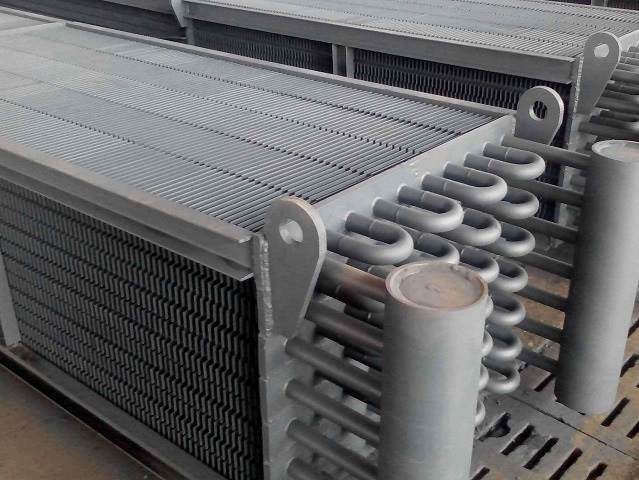Lord Fin Tube-What is an economizer?
An economizer is a mechanical device designed to reduce energy consumption or perform a useful function, such as preheating a fluid. It functions as a heat exchanger, capturing waste heat from one process to be used in another.
Economizers in Steam Boilers
In the context of a steam boiler, an economizer is a heat exchanger device that heats fluids or recovers residual heat from combustion products (flue gases) in a thermal power plant before these gases are released through the chimney. Flue gases typically consist of nitrogen, carbon dioxide, water vapor, soot, carbon monoxide, etc. The economizer in thermal power plants serves to economize the process of electrical power generation by preheating boiler feed water using the recovered heat, thus reducing fuel consumption and increasing efficiency.
Economizers Functionality
Placement: The economizer is situated between the boiler exit and the chimney entry.
Structure: It comprises numerous smalldiameter thinwalled tubes placed between two headers. Flue gases flow outside these tubes, usually in a counterflow arrangement.
Operation: Flue gases exit the steam boiler furnace carrying significant heat. The economizer recovers some of this heat to preheat the boiler feed water, which is eventually converted to superheated steam. This process saves fuel by utilizing waste heat.
Economizers Applications
1. Steam Power Plants: Captures waste heat from boiler stack gases and transfers it to the boiler feed water.
2. HVAC Systems: Airside economizers save energy by using cool outside air to cool indoor spaces.
3. Refrigeration: Used in industrial refrigeration to perform part of the refrigeration work at high pressures, where gas compressors are more efficient.
Economizers Advantages and Benefits
Enhanced Heat Recovery: Recovers more heat from flue gases than standard air preheaters.
Fuel Savings: Reduces fuel consumption, increasing boiler efficiency.
Water Conservation: Reduces the need for large quantities of water to cool flue gases before desulfurization.
Efficiency Improvement: Minimizes the efficiency loss when steam air preheaters require steam.
Types of Economizers
1. Fluid Economizers
WaterSide Economizers: These are typically used in HVAC systems and power plants. They transfer heat from the flue gases to the boiler feed water. In HVAC systems, they use the cool outside air to assist in cooling water or other fluids within the system.
AirSide Economizers: Common in HVAC applications, these economizers use cool outside air to reduce the load on air conditioning systems. They can switch to outside air when it is cooler than the recirculated indoor air, reducing the need for mechanical cooling.
2. Thermal Economizers
Steam Economizers: Used in steam power plants to capture waste heat from boiler stack gases and preheat the feed water before it enters the boiler. This increases the boilers efficiency and reduces fuel consumption.
Condensing Economizers: These are designed to condense the water vapor in the flue gases to recover the latent heat of vaporization. This type is highly efficient and can recover more heat than traditional economizers.
3. NonCondensing Economizers
Standard NonCondensing Economizers: These economizers recover heat from flue gases to preheat the feed water but do not condense the water vapor in the gases. They are simpler in design and typically less expensive than condensing economizers.
4. HVAC Economizers
DryBulb Economizers: These use the drybulb temperature of the outside air to determine when it is suitable for free cooling. If the outside air temperature is below a certain threshold, the economizer allows outside air to cool the building.
WetBulb Economizers: These use the wetbulb temperature (which considers humidity) to determine when outside air can be used for cooling. They are more efficient in humid climates.
5. Industrial Economizers
Refrigeration Economizers: Used in industrial refrigeration systems where vapor compression is essential. These economizers can produce part of the refrigeration work at high pressures, where gas compressors operate more efficiently.
Boiler Economizers: Used in industrial boilers to capture waste heat from flue gases and preheat boiler feed water. They enhance boiler efficiency and reduce fuel consumption.
Economizers Design Configurations
1. Coil Tube Economizers: Use coiled tubes to increase the heat exchange surface area. They are compact and efficient, suitable for smaller installations.
2. Finned Tube Economizers: Have fins attached to the tubes to increase the surface area for heat exchange. These are common in large industrial applications.
3. Shell and Tube Economizers: Consist of a shell with tubes running through it. The flue gases pass over the tubes, transferring heat to the fluid inside. They are durable and efficient, suitable for highpressure applications.
Advantages of Economizers
Energy Efficiency: They significantly improve the overall efficiency of the system by utilizing waste heat.
Fuel Savings: Reduce the amount of fuel needed for heating processes, leading to cost savings.
Environmental Benefits: Lower fuel consumption results in reduced greenhouse gas emissions and other pollutants.
Extended Equipment Life: By preheating the feed water, economizers reduce thermal shock and stress on the boiler, extending its lifespan.
Economizers are crucial in modern plants, contributing to energy savings and operational efficiency in various applications, including power generation, HVAC systems, and industrial refrigeration.

Economizers|Heat exchanger Economizers

